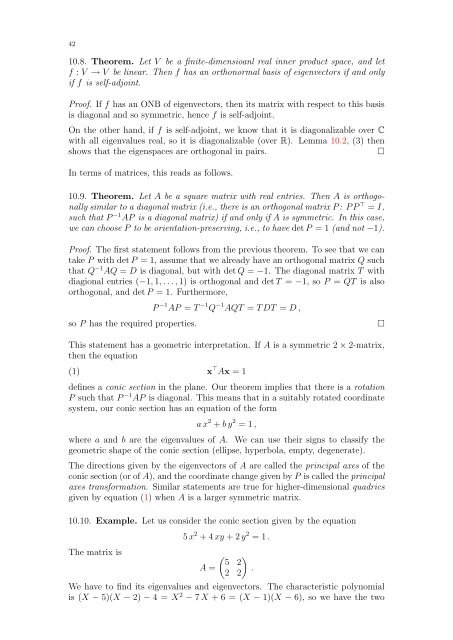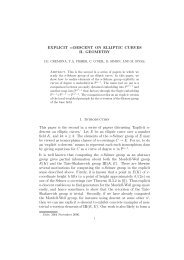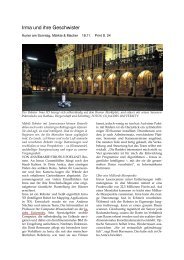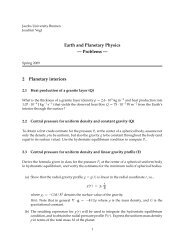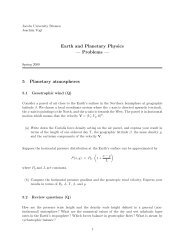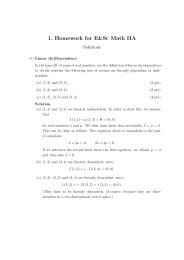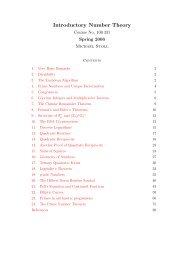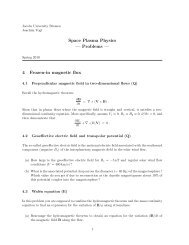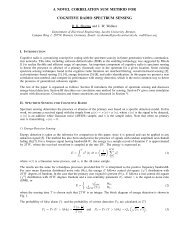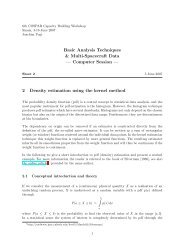Linear Algebra II (pdf, 500 kB)
Linear Algebra II (pdf, 500 kB)
Linear Algebra II (pdf, 500 kB)
Create successful ePaper yourself
Turn your PDF publications into a flip-book with our unique Google optimized e-Paper software.
42<br />
10.8. Theorem. Let V be a finite-dimensioanl real inner product space, and let<br />
f : V → V be linear. Then f has an orthonormal basis of eigenvectors if and only<br />
if f is self-adjoint.<br />
Proof. If f has an ONB of eigenvectors, then its matrix with respect to this basis<br />
is diagonal and so symmetric, hence f is self-adjoint.<br />
On the other hand, if f is self-adjoint, we know that it is diagonalizable over C<br />
with all eigenvalues real, so it is diagonalizable (over R). Lemma 10.2, (3) then<br />
shows that the eigenspaces are orthogonal in pairs. <br />
In terms of matrices, this reads as follows.<br />
10.9. Theorem. Let A be a square matrix with real entries. Then A is orthogonally<br />
similar to a diagonal matrix (i.e., there is an orthogonal matrix P : P P ⊤ = I,<br />
such that P −1 AP is a diagonal matrix) if and only if A is symmetric. In this case,<br />
we can choose P to be orientation-preserving, i.e., to have det P = 1 (and not −1).<br />
Proof. The first statement follows from the previous theorem. To see that we can<br />
take P with det P = 1, assume that we already have an orthogonal matrix Q such<br />
that Q −1 AQ = D is diagonal, but with det Q = −1. The diagonal matrix T with<br />
diagional entries (−1, 1, . . . , 1) is orthogonal and det T = −1, so P = QT is also<br />
orthogonal, and det P = 1. Furthermore,<br />
P −1 AP = T −1 Q −1 AQT = T DT = D ,<br />
so P has the required properties. <br />
This statement has a geometric interpretation. If A is a symmetric 2 × 2-matrix,<br />
then the equation<br />
(1) x ⊤ Ax = 1<br />
defines a conic section in the plane. Our theorem implies that there is a rotation<br />
P such that P −1 AP is diagonal. This means that in a suitably rotated coordinate<br />
system, our conic section has an equation of the form<br />
a x 2 + b y 2 = 1 ,<br />
where a and b are the eigenvalues of A. We can use their signs to classify the<br />
geometric shape of the conic section (ellipse, hyperbola, empty, degenerate).<br />
The directions given by the eigenvectors of A are called the principal axes of the<br />
conic section (or of A), and the coordinate change given by P is called the principal<br />
axes transformation. Similar statements are true for higher-dimensional quadrics<br />
given by equation (1) when A is a larger symmetric matrix.<br />
10.10. Example. Let us consider the conic section given by the equation<br />
The matrix is<br />
5 x 2 + 4 xy + 2 y 2 = 1 .<br />
A =<br />
<br />
5 2<br />
.<br />
2 2<br />
We have to find its eigenvalues and eigenvectors. The characteristic polynomial<br />
is (X − 5)(X − 2) − 4 = X 2 − 7 X + 6 = (X − 1)(X − 6), so we have the two


